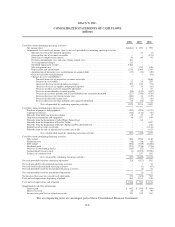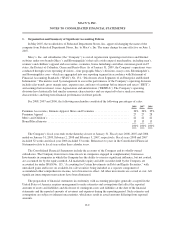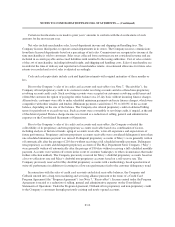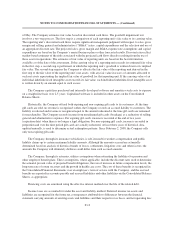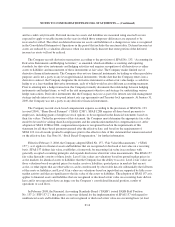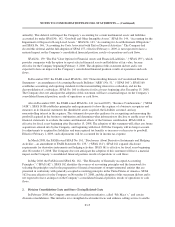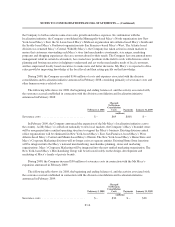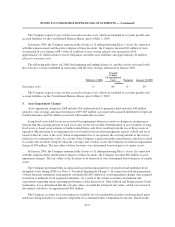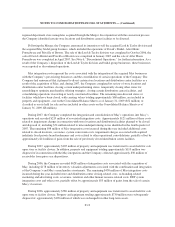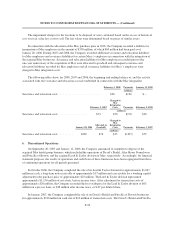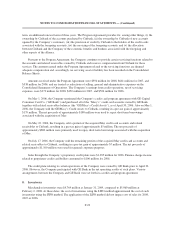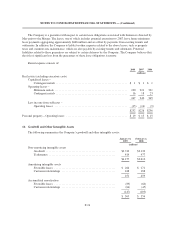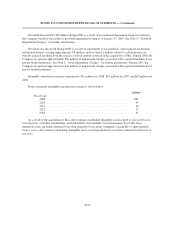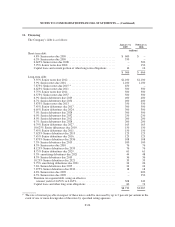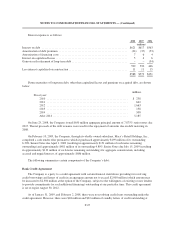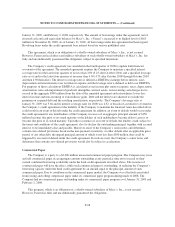Macy's 2008 Annual Report Download - page 66
Download and view the complete annual report
Please find page 66 of the 2008 Macy's annual report below. You can navigate through the pages in the report by either clicking on the pages listed below, or by using the keyword search tool below to find specific information within the annual report.
NOTES TO CONSOLIDATED FINANCIAL STATEMENTS — (Continued)
current economic environment, it was determined that the carrying value of certain marketable securities
exceeded the current fair value on an “other-than-temporary” basis, by approximately $12 million, and the
previously unrecognized losses in accumulated other comprehensive income were reclassified into the
Consolidated Statements of Operations.
4. Goodwill Impairment Charges
Based on the results of goodwill impairment testing as of January 31, 2009, the Company recorded an
estimated pre-tax goodwill impairment charge of $5,382 million, $5,083 million after income taxes, in the fourth
quarter of 2008. Any adjustment to this amount resulting from the completion of the measurement of the
impairment charge will be recognized in a subsequent reporting period.
The Company completed its annual impairment testing of goodwill and indefinite lived intangible assets
during the second quarter of 2008 and concluded that no goodwill write-downs or impairment charges were
required at that time. After evaluating the results of the Christmas selling season, and in consideration of the
continued deterioration in the general economic environment in recent periods (and the impact thereof on the
Company’s most recently completed annual business plan) and the resultant continued decline in the Company’s
market capitalization, the Company believed that an additional goodwill impairment test was required as of
January 31, 2009.
The goodwill impairment test involves a two-step process. The first step is a comparison of each reporting
unit’s fair value to its carrying value. The Company estimates fair value based on discounted cash flows. The
reporting unit’s discounted cash flows require significant management judgment with respect to sales, gross
margin and SG&A rates, capital expenditures and the selection and use of an appropriate discount rate. The
projected sales, gross margin and SG&A expense rate assumptions and capital expenditures are based on the
Company’s annual business plan or other forecasted results. Discount rates reflect market-based estimates of the
risks associated with the projected cash flows directly resulting from the use of those assets in operations.
The Company initially calculated the value of its reporting units by discounting their projected future cash
flows to present value using the Company’s estimated weighted average cost of capital as the discount rate,
which produced a value of each of the Company’s Macy’s reporting units that exceeded its carrying value.
However, the reconciliation of these values of the Company’s reporting units to the Company’s market
capitalization resulted in an implied fair value substantially in excess of its market capitalization. In order to
reconcile the discounted cash flows of the Company’s reporting units to the trading value of the Company’s
common stock, the Company applied discount rates higher than the Company’s estimated weighted average cost
of capital, representing a market participant approach, to the projected cash flows of its reporting units and
determined that the carrying value of each of the Company’s reporting units exceeded its fair value at January 31,
2009, which resulted in all of the Company’s reporting units failing the first step of the goodwill impairment test.
The second step required the Company to allocate the fair value of the reporting unit derived in the first step
to the fair value of the reporting unit’s net assets. The Company calculated the fair values of each reporting unit’s
net assets, including obtaining third-party appraisals of substantially all of the tangible and intangible assets and
the fair value in excess of amounts allocated to such net assets represented the implied fair value of goodwill for
that reporting unit. Each reporting unit’s goodwill was written down to its implied fair value derived in the
second step. Due to the complexity of this process, the Company will not complete the measurement of the
implied fair value of goodwill for each reporting unit until a subsequent reporting period and, accordingly, the
goodwill impairment charge in the Consolidated Statements of Operations represents an estimate.
5. May Integration Costs
On August 30, 2005, the Company completed the acquisition of The May Department Stores Company
(“May”) (the “Merger”). The Company added about 400 Macy’s locations nationwide in 2006 as it converted the
F-18


